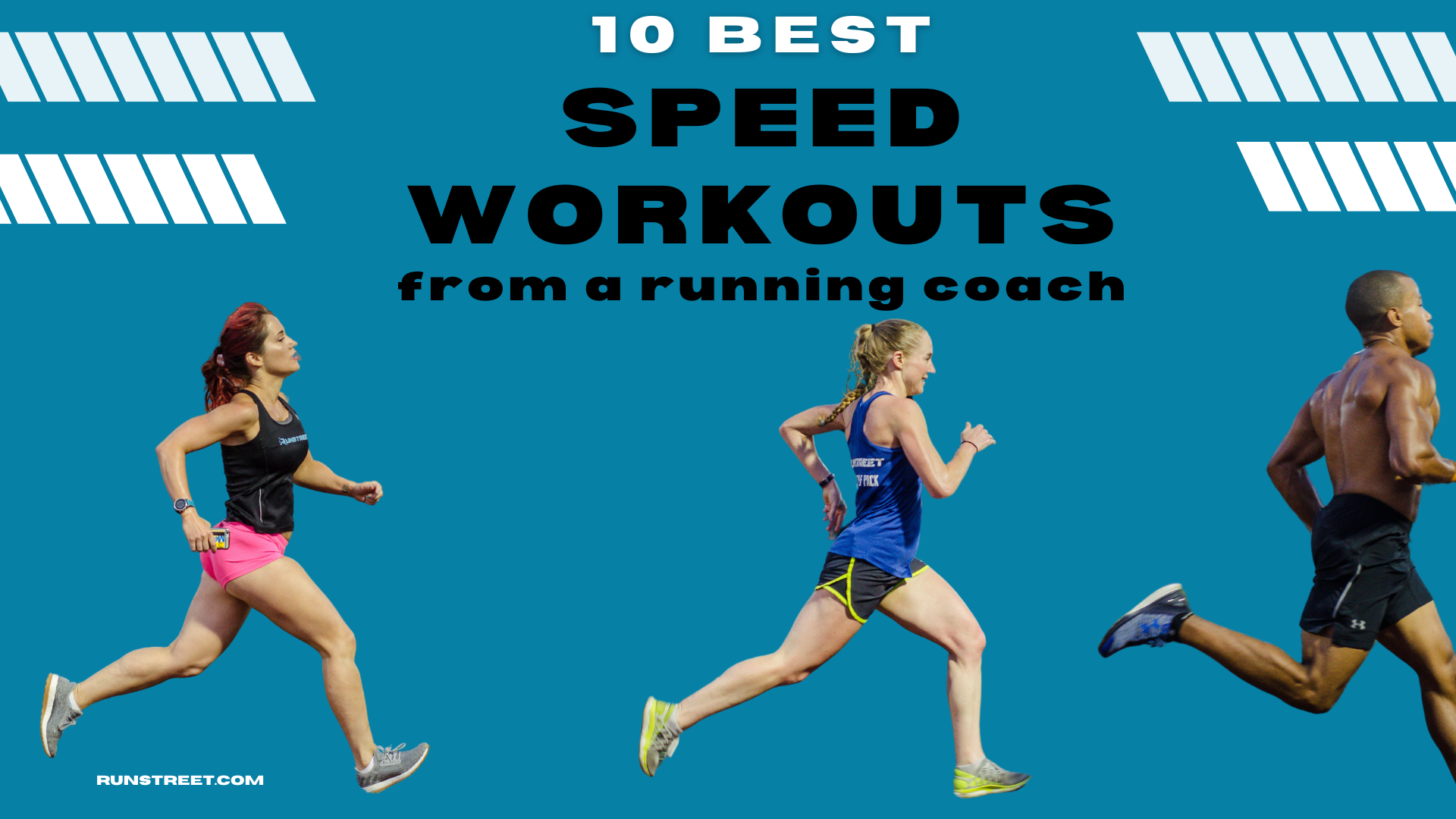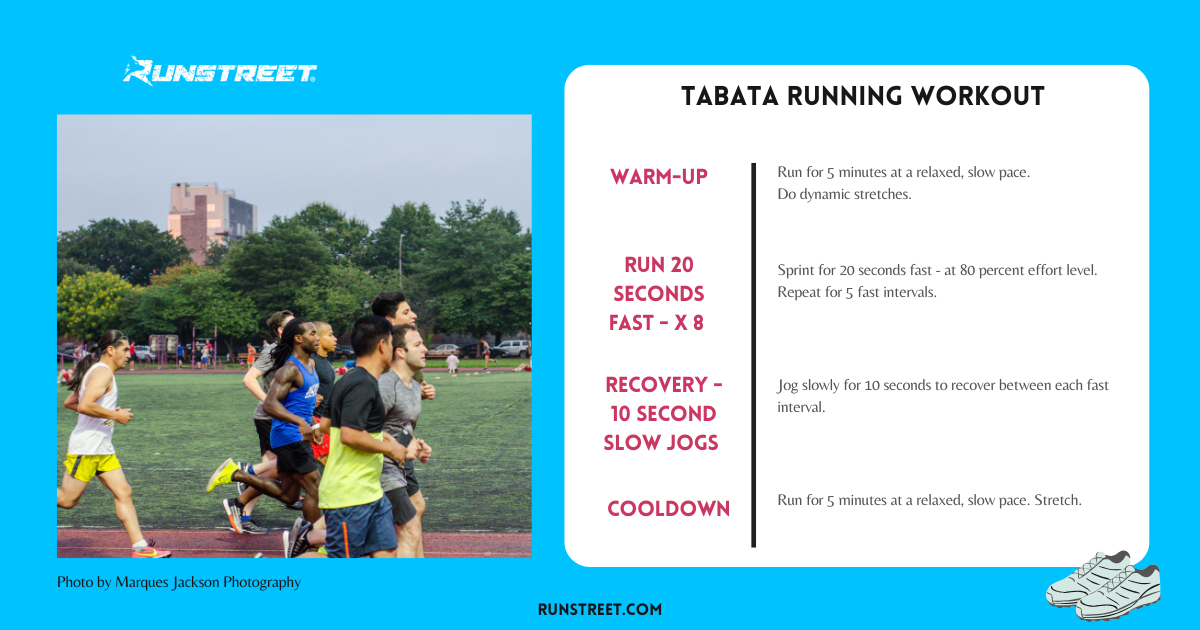Running HIIT Workout Guide
Plus 3 Sample HIIT Running Workouts
By Marnie Kunz,
NASM-certified trainer, USATF- RRCA-certified run coach
Whether you want to lose weight or step up your fitness level, running HIIT workouts are a great way to increase your running efficiency and calorie-burning, and build speed and stamina in a short amount of time. I’ve compiled this running HIIT workout guide to cover everything you need to know to get started. I’ve also included three sample workouts that you can try at any fitness level. I'm a personal trainer who's been helping runners improve their endurance, speed, and fitness level for over 15 years. HIIT training is an excellent way to burn calories and promote fat loss in a healthy, sustainable way.
HIIT Workout Overview
What is a HIIT workout? HIIT stands for high-intensity interval training and is a form of workout that includes intense bursts of exercise with short rest periods. HIIT workouts have become a huge trend in recent years and unlike most fitness trends, they’ve stuck around because they are so effective. HIIT workouts are one of the fastest ways to get your heart rate up, lose weight, get toned, and improve cardio fitness.
HIIT workouts are usually 30 minutes or less, so you can accomplish a lot of training in a short amount of time. Another benefit of HIIT workouts is that they are very adaptable to different forms of exercise, including running. HIIT sessions boost your calorie burning and can help with losing or maintaining a healthy weight. Adding a running HIIT workout to your workout routine each week can help you become a stronger runner and boost your overall fitness.
What Is A Running HIIT Workout?
A running HIIT workout includes intense bursts of running mixed with short rest intervals. There are many options for doing running HIIT workouts, including Tabata running, interval sprints, fartlek workouts, and hill intervals. In contrast with steady-state cardio runs like base runs or tempo runs, HIIT running workouts involve periods of pushing yourself to the max followed by slow, recovery segments.
You can adapt any running HIIT workout to all fitness levels. So whether you’re a beginning runner or an advanced marathoner, you can improve your speed and stamina by incorporating some running HIIT workouts into your training program.
Benefits of HIIT Workouts
There are many benefits of running HIIT workouts — including burning a high amount of calories, which helps with weight loss. A running HIIT workout also will help improve your running speed and stamina if you do it regularly. HIIT workouts are a great way to boost your fitness level in a shorter amount of time than most other forms of running, like base runs (relaxed pace runs).
Here are just a few of the many benefits of HIIT workouts:
Shorter workout times
If you do a running HIIT workout, you only need to do 30 minutes (or even less, depending on the workout) to get excellent fitness benefits. This is great for busy people and anyone with a short attention span. If you get bored fast, the HIIT workout is always changing between rest and work cycles so it moves a lot faster than a regular, slow base run. And if you’re training on a treadmill, HIIT workouts are a great way to break up the monotony.
High Calorie Burn
You burn a high amount of calories during and after a running HIIT workout. During HIIT running workouts, your body metabolizes calories and fat much faster than during lower-intensity workouts. Your metabolism also stays elevated and your body continues to burn calories for hours after your running HIIT workout.
Reduced body fat
Running HIIT workouts offer many benefits.
According to the American Council on Exercise, HIIT workouts reduce abdominal fat and subcutaneous fat, which is the fat just under your skin. This is great news for anyone who wants to cut down on their belly or reduce overall body fat.
Improved aerobic efficiency
Running HIIT workouts improves your body’s stroke volume and oxygen efficiency. This will help your body perform more efficiently when running, which is especially helpful for improving your race times.
Quicker recovery time
As you do a running HIIT workout, your body accumulates lactic acid from the intense bursts of running. The active recovery periods remove waste buildup as you work out, so your body learns to tolerate high-intensity running and recover more readily.
Improved muscle definition and volume
Running HIIT workouts place a high demand on your muscle tissue. As you recover, the body produces elevated levels of human growth hormone and other hormones that help your muscles rebuild and repair to become stronger and more defined.
Better Heart Health
According to the American College of Sports Medicine, regular HIIT workouts improve caqrdiovascular health, blood pressure, and cholesterol levels. HIIT running workouts strengthen your heart.
Sprint intervals are a great way to do HIIT training.
Running HIIT Workout: Sprint Intervals
Sprint intervals are a great way to do a running HIIT workout. Intervals are measured bursts of speed followed by periods of active recovery. This is a sample running HIIT workout with sprint intervals. You can adapt the workout to your fitness level and goals, adding more speed intervals for an advanced workout or doing fewer intervals if you are a beginner. If you want to add more mileage to your run, you can also run a longer warm-up and cooldown.
For this workout, if you are on a standard running track, you will be doing intervals of 200 meters, or one-half lap of a standard track. You can also use your running watch or GPS running app to measure the distance if you’re not on a track.
Warm-up: Run one-half of a mile (or 800 meters) at a relaxed pace. This should be a conversational pace and feel like an effort of 2 or 3 (on an effort scale of 1 to 10, with 10 being the hardest). Do dynamic stretches.
Sprint for one-eighth of a mile (200 meters) at a 90 percent effort level. This should feel like a 9 out of 10 on the effort scale. You will not be able to talk at this pace and will be out of breath. You will be going at almost your fastest speed.
Recover with a slow jog for one-eighth of a mile (200 meters). Go at an easy, relaxed pace. This is your active recovery.
Repeat the sprint-recover segments for a total of 6 fast intervals and 6 recovery segments.
Cooldown: Run one-half of a mile (or 800 meters) at a relaxed pace. This should be a conversational pace and feel like an effort of 2 or 3. Stretch.
Try this HIIT running hill workout to get stronger and faster.
Running HIIT Workout: Hill Intervals
Hill workouts are great for improving leg strength, speed, and running form. This running HIIT workout uses hills to add intensity to your intervals. As with the other workouts, you can add more intervals for an advanced-level workout or start with fewer intervals if you are a beginner.
For the hill, choose a medium to steep hill that is large enough to be able to run for 30 seconds up the hill. You do not want a very low-grade hill or a short hill.
Warm-up: Run one-half of a mile (or 800 meters) at a relaxed pace. This should be a conversational pace and feel like an effort of 2 or 3 (on an effort scale of 1 to 10, with 10 being the hardest). Do dynamic stretches.
Sprint for 30 seconds up a hill. This should feel like a 9 out of 10 on the effort scale. You will not be able to talk at this pace and will be out of breath. You will not be going as fast as a flat sprint but will be almost maxing out on the effort scale.
Recover with a slow jog down the hill. Go at an easy, relaxed pace. This is your active recovery.
Repeat the hill sprint-recover segments for a total of 5 fast intervals and 5 recovery segments.
Cooldown: Run one-half of a mile (or 800 meters) at a relaxed pace. This should be a conversational pace and feel like an effort of 2 or 3 (on an effort scale of 1 to 10). Stretch.
Tabata running offers a short, intense HIIT workout.
Running HIIT Workout: Tabata
Tabata workouts are a form of high-intensity interval training with short, 20-second bursts of high intensity followed by 10 seconds of recovery. Tabata training is a great way to mix up your running routine and get in a running HIIT workout in just 14 minutes. This is an excellent workout if you are short on time but still want to get in some speed work and high intensity.
Warm-Up: 5 minutes relaxed pace run to warm up. Do dynamic stretches.
Sprint: 20 seconds sprinting, at 90 percent effort level
Recovery: 10 seconds rest, slow jog
Repeat for a total of 8 fast bursts and 4 minutes of Tabata time.
Cooldown: Run for 5 minutes at a relaxed pace. This should be a conversational pace and feel like an effort of 2 or 3 (on an effort scale of 1 to 10). Stretch.
Total Workout Time: 14 minutes
When you do these running HIIT workouts, be sure to do some dynamic stretches as part of your warm-up. If you want more workout time or more mileage for your runs, you can add more intervals or do longer warm-ups and cooldowns.
If you are interested in more weight loss workouts, check out my 6 Best Running Workouts to Lose Weight.
Have you tried a running HIIT workout? Let me know what you think in the comments. Get a running training plan to crush your goals in our Training Center. Follow and tag @Runstreet on Instagram to share your workouts and get cheered on.
Related Posts: How to Do Tabata Running Workouts, Runner’s Guide to Hill Workouts, 5 Running Workouts to Get Faster, Interval Training for Beginners, 6 Best Running Workouts to Lose Weight
Marnie Kunz is a NASM-certified personal trainer, USATF and RRCA-certified running coach, and the creator of Runstreet. She is a Brooklyn writer, Akita mom, and dog lover.







